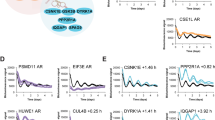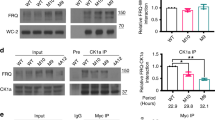Abstract
At the core of the mammalian circadian clock is a feedback loop in which the heterodimeric transcription factor CLOCK–Brain, Muscle Arnt-like-1 (BMAL1) drives expression of its negative regulators, periods (PERs) and cryptochromes (CRYs). Here, we provide evidence that CLOCK-Interacting Protein, Circadian (CIPC) is an additional negative-feedback regulator of the circadian clock. CIPC exhibits circadian regulation in multiple tissues, and it is a potent and specific inhibitor of CLOCK–BMAL1 activity that functions independently of CRYs. CIPC–CLOCK protein complexes are present in vivo, and depletion of endogenous CIPC shortens the circadian period length. CIPC is unrelated to known proteins and has no recognizable homologues outside vertebrates. Our results suggest that negative feedback in the mammalian circadian clock is divided into distinct pathways, and that the addition of new genes has contributed to the complexity of vertebrate clocks.
This is a preview of subscription content, access via your institution
Access options
Subscribe to this journal
Receive 12 print issues and online access
$209.00 per year
only $17.42 per issue
Buy this article
- Purchase on Springer Link
- Instant access to full article PDF
Prices may be subject to local taxes which are calculated during checkout






Similar content being viewed by others
References
Young, M. W. & Kay, S. A. Time zones: a comparative genetics of circadian clock. Nature Rev. Genet. 2, 702–715 (2001).
Lowrey, P. L. & Takahashi, J. S. Genetics of the mammalian circadian system: photic entrainment, circadian pacemaker mechanisms, and posttranslational regulation. Annu. Rev. Genet. 34, 533–562 (2000).
Sato, T. K. et al. Feedback repression is required for mammalian circadian clock function. Nature Genet. 38, 312–319 (2006).
Yamazaki, S. et al. Resetting central and peripheral circadian oscillators in transgenic rats. Science 288, 682–685 (2000).
Balsalobre, A. et al. Resetting of circadian time in peripheral tissues by glucocorticoid signaling. Science 289, 2344–2347 (2000).
Balsalobre, A., Damiola, F. & Schibler, U. A serum shock induces circadian gene expression in mammalian tissue culture cells. Cell 93, 929–937 (1998).
Akhtar, R. A. et al. Circadian cycling of the mouse liver transcriptome, as revealed by cDNA microarray, is driven by the suprachiasmatic nucleus. Curr. Biol. 12, 540–550 (2002).
Duffield, G. E., Best, J. D., Meurers, B. H., Bittner, A., Loros, J. J. & Dunlap, J. C. Circadian programs of transcriptional activation, signaling, and protein turnover revealed by microarray analysis of mammalian cells. Curr. Biol. 12, 551–557 (2002).
Panda, S. et al. Coordinated transcription of key pathways in the mouse by the circadian clock. Cell 109, 307–320 (2002).
Storch, K.-F. et al. Extensive and divergent circadian gene expression in liver and heart. Nature 417, 78–83 (2002).
Gachon, F., Nagoshi, E., Brown, S. A., Ripperger, J. & Schibler, U. The mammalian circadian timing system: from gene expression to physiology. Chromosoma 113, 103–112 (2004).
Ouyang, Y., Andersson, C. R., Kondo, T., Golden, S. S. & Johnson, C. H. Resonating circadian clocks enhance fitness in cyanobacteria. Proc. Natl Acad. Sci. USA. 95, 8660–8664 (1998).
Dodd, A. N. et al. Plant circadian clocks increase photosynthesis, growth, survival, and competitive advantage. Science 309, 630–633 (2005).
Gekakis, N. et al. Role of the CLOCK protein in the mammalian circadian mechanism. Science 280, 1564–1569 (1998).
Yoo, S. H. et al. A noncanonical E-box enhancer drives mouse Period2 circadian oscillations in vivo. Proc. Natl Acad. Sci. USA 102, 2608–2613 (2005).
Sangoram, A. M. et al. Mammalian circadian autoregulatory loop: a timeless ortholog and mPer1 interact and negatively regulate CLOCK–BMAL1-induced transcription. Neuron 21, 1101–1113 (1998).
Kume, K. et al. mCRY1 and mCRY2 are essential components of the negative limb of the circadian clock feedback loop. Cell 98, 193–205 (1999).
Griffin, E. A., Staknis, D. & Weitz, C. J. Light-independent role of CRY1 and CRY2 in the mammalian circadian clock. Science 286, 768–771 (1999).
Yagita, K. et al. Dimerization and nuclear entry of mPER proteins in mammalian cells. Gene Dev. 14, 1353–1363 (2000).
Glossup, N. R., Lyons, L. C. & Hardin, P. E. Interlocked feedback loops within the Drosophila circadian oscillator. Science 286, 766–768 (1999).
Lee, K., Loros, J. J. & Dunlap, J. C. Interconnected feedback loops in the Neurospora circadian system. Science 289, 107–110 (2000).
Shearman, L. P. et al. Interacting molecular loops in the mammalian circadian clock. Science 288, 1013–1119 (2000).
Preitner, N. et al. The orphan nuclear receptor REV–ERBα controls circadian transcription within the positive limb of the mammalian circadian oscillator. Cell 110, 251–260 (2002).
Lowrey, P. L. et al. Positional syntenic cloning and functional characterization of the mammalian circadian mutation tau. Science 288, 483–491 (2000).
Vielhaber, E., Eide, E., Rivers, A., Gao, Z. H. & Virshup, D. M. Nuclear entry of the circadian regulator mPER1 is controlled by mammalian casein kinase Iε. Mol. Cell Biol. 20, 4888–4899 (2000).
Field, M. D. et al. Analysis of clock proteins in mouse SCN demonstrates phylogenetic divergence of the circadian clockwork and resetting mechanisms. Neuron 25, 437–447 (2000).
Barnes, J. W. et al. Requirement of mammalian timeless for circadian rhythmicity. Science 302, 439–442 (2003).
Honma, S. et al. Dec1 and Dec2 are regulators of the mammalian molecular clock. Nature 419, 841–844 (2002).
Brown, S. A. et al. PERIOD1-associated proteins modulate the negative limb of the mammalian circadian oscillator. Science 308, 693–696 (2005).
King, D. P. et al. Positional cloning of the mouse circadian clock gene. Cell 89, 641–653 (1997).
Doi, M., Hirayama, J. & Sassone-Corsi, P. Circadian regulator CLOCK is a histone acetyltransferase. Cell 125, 497–508 (2006).
Nagoshi, E. et al. Circadian gene expression in individual fibroblasts: cell-autonomous and self-sustained oscillators pass time to daughter cells. Cell 119, 693–705 (2004).
van der Horst, G. T. et al. Mammalian Cry1 and Cry2 are essential for maintenance of circadian rhythms. Nature 398, 627–630 (1999).
Vitaterna, M. H. et al. Differential regulation of mammalian Period genes and circadian rhythmicity by cryptochromes 1 and 2. Proc. Natl Acad. Sci. USA 96, 12114–12119 (1999).
Antoch, M. P. et al. Functional identification of the mouse circadian Clock gene by transgenic BAC rescue. Cell 89, 655–667 (1997).
Bae, K. et al. Differential Functions of mPer1, mPer2, and mPer3 in the SCN Circadian Clock. Neuron 30, 525–536 (2001).
Zheng, B. et al. The mPer2 gene encodes a functional component of the mammalian circadian clock. Nature 400, 169–173 (1999).
Lee, C., Etchegaray, J. P., Cagampang, F. R., Loudon, A. S. & Reppert, S. M. Posttranslational mechanisms regulate the mammalian circadian clock. Cell 107, 855–867 (2001).
Acknowledgements
We thank Choogon Lee for advice on immunoprecipitation and D. Knutti and K.-F. Storch for helpful comments on the manuscript. This work was supported by the National Institutes of Health (NIH; R01-MH59943; C.J.W.), by a Dana-Mahoney Fellowship from the Dana Foundation (W.-N.Z.), and by the Deutsche Forschungsgemeinschaft and the 6th Framework Project EUCLOCK (A.K.).
Author information
Authors and Affiliations
Corresponding author
Ethics declarations
Competing interests
The authors declare no competing financial interests.
Supplementary information
Supplementary Information
Supplementary figures S1, S2, S3, S4, S5, Supplementary Notes and Supplementary Methods (PDF 631 kb)
Rights and permissions
About this article
Cite this article
Zhao, WN., Malinin, N., Yang, FC. et al. CIPC is a mammalian circadian clock protein without invertebrate homologues. Nat Cell Biol 9, 268–275 (2007). https://doi.org/10.1038/ncb1539
Received:
Accepted:
Published:
Issue Date:
DOI: https://doi.org/10.1038/ncb1539
This article is cited by
-
The mediating effect of DNA methylation in the association between maternal sleep during pregnancy and offspring adiposity status: a prospective cohort study
Clinical Epigenetics (2022)
-
The Influence of Short-term Fasting on Muscle Growth and Fiber Hypotrophy Regulated by the Rhythmic Expression of Clock Genes and Myogenic Factors in Nile Tilapia
Marine Biotechnology (2018)
-
A Ras GTPase associated protein is involved in the phototropic and circadian photobiology responses in fungi
Scientific Reports (2017)
-
Cryptochrome 1 regulates the circadian clock through dynamic interactions with the BMAL1 C terminus
Nature Structural & Molecular Biology (2015)
-
Histone monoubiquitination by Clock–Bmal1 complex marks Per1 and Per2 genes for circadian feedback
Nature Structural & Molecular Biology (2015)



